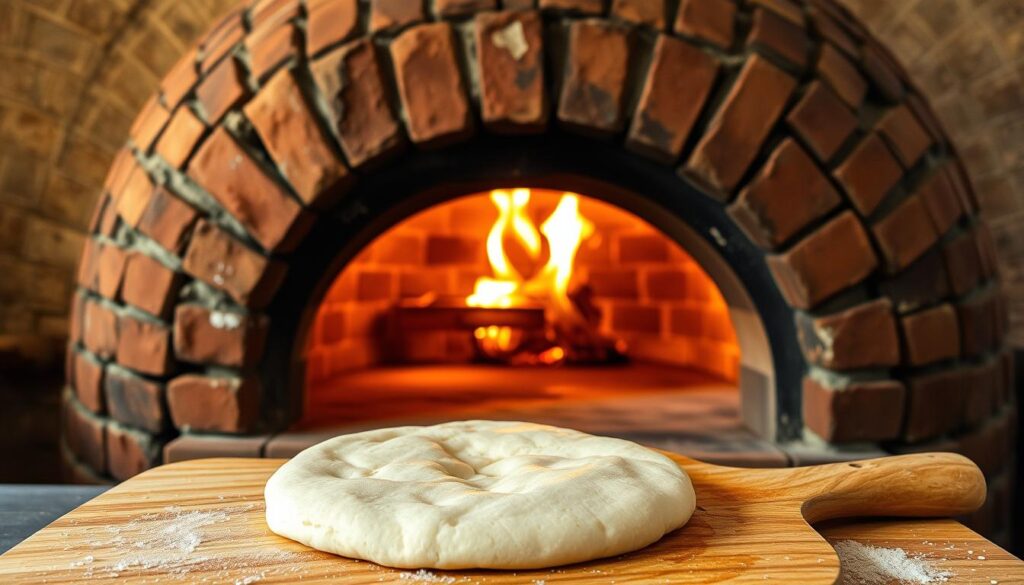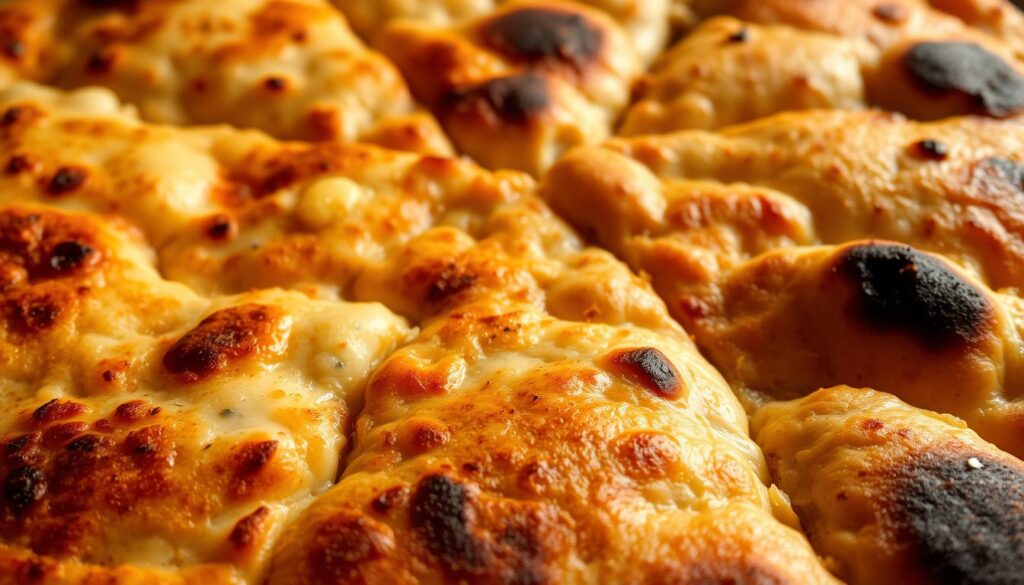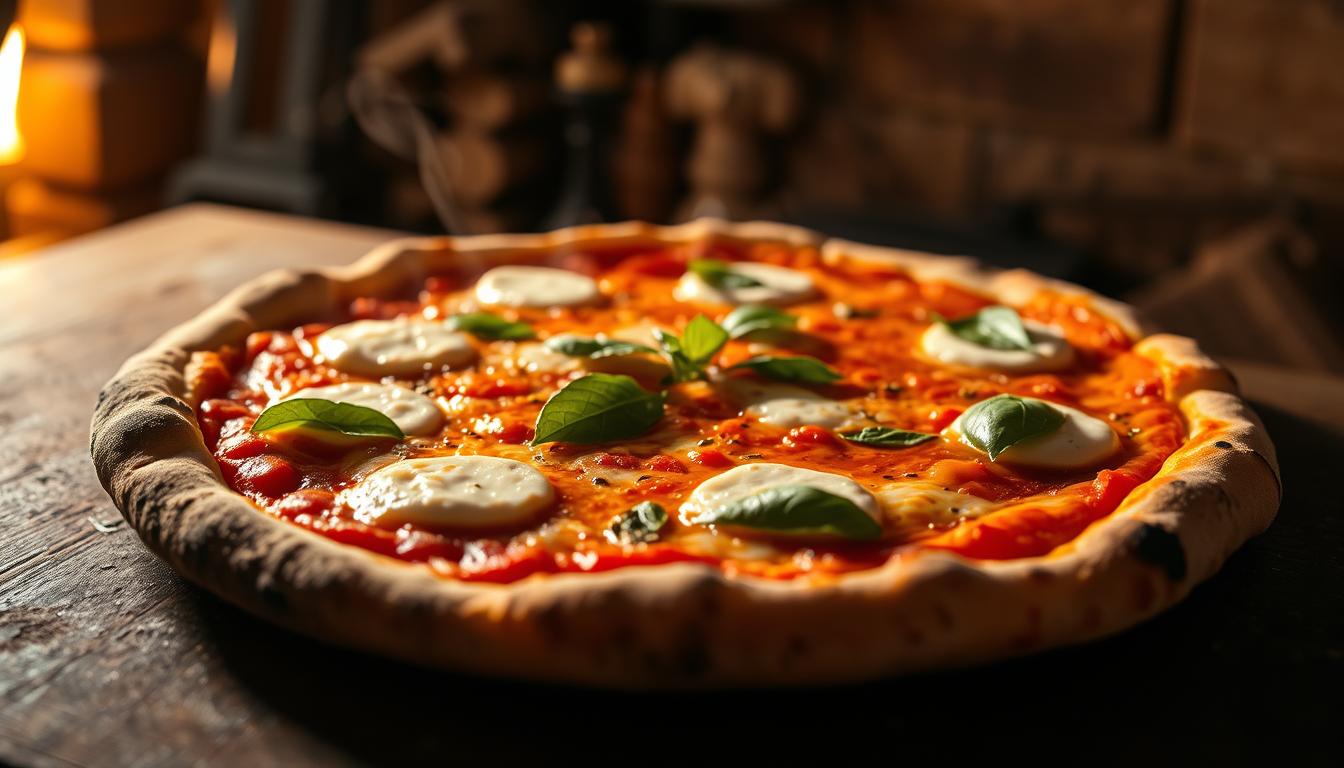Imagine stepping into a cozy kitchen. The smell of fresh dough and melting mozzarella fills the air. You’re about to make a dish that’s as good as your favorite pizzeria. Making italian pizza at home is fun, and with some tips, you’ll have a tasty pie ready soon.
Whether you’re a pro in the kitchen or just starting, this guide is for you. It shows how to make delicious italian cuisine in your own kitchen. You’ll learn how to make the perfect crust, pick the best toppings, and get the flavors just right.
Table of Contents
Key Takeaways
- Simple steps to making authentic italian pizza at home
- Tips for achieving the perfect crust and flavor combination
- Essential toppings and ingredients for a delicious pizza
- Common mistakes to avoid when making italian pizza
- Variations and creative ideas to take your pizza game to the next level
The Rich History of Italian Pizza
Italian pizza has a fascinating history that started in Naples. It’s amazing to think this tasty dish has been around since the 18th century.
The roots of pizza are in Neapolitan cuisine. It was first a street food, cooked in wood-fired ovens. It was topped with olive oil, garlic, and anchovies. This is how the classic Napoli style pizza was born.
From Naples to the World: Pizza’s Origin Story
Pizza’s journey from Naples to the world is a story of migration and cultural exchange. Italians took their food traditions with them, making pizza for local tastes. Yet, they kept its traditional Italian pizza spirit.
How Pizza Became an International Sensation
After WWII, pizza became famous worldwide. American soldiers brought back the love for Neapolitan pizza. This started a global pizza craze. Different places made their own pizza styles, but still honored the Napoli style pizza.
Now, Italian pizza is loved all over the world. Its rich history and cultural importance keep inspiring pizza lovers of all ages.
What Makes Authentic Italian Pizza Different
Italian pizza is all about simplicity and variety. It’s made with a few top-notch ingredients. This creates a dish that highlights the beauty of keeping things simple.
The Simplicity of True Italian Pizza
True Italian pizza is simple. It doesn’t have lots of toppings like some other pizzas. Instead, it focuses on a few key things: a great crust, fresh tomatoes, mozzarella cheese, and basil.
This approach lets each ingredient stand out. It makes a pizza that tastes amazing because of its balance.
Regional Variations Across Italy
Italy has many different pizza styles. Each one shows off local tastes and ingredients. For example, Naples is famous for its soft crust and fresh toppings.
Rome, on the other hand, has pizzas that are thinner and crisper. This variety makes Italian pizza exciting.
Comparing Italian vs. American-Style Pizza
American pizza is different from Italian pizza. Italian pizzas focus on quality and simplicity. American pizzas, however, have lots of toppings and different crusts.
American pizzas are often thicker and more loaded. This shows how local tastes and preferences can change pizza.
Knowing these differences helps you enjoy authentic Italian pizza more. It also helps you make your own pizzas at home.
Essential Ingredients for Perfect Italian Pizza
Making authentic Italian pizza at home starts with the best ingredients. The simplicity of Italian pizza shows how important quality is in its parts.
Flour Selection: The Foundation of Great Pizza
The flour you choose is key for the best Italian pizza. Caputo or “00” flour is top choice. It has a fine texture and low protein, making the crust tender.
The Importance of San Marzano Tomatoes
San Marzano tomatoes are essential for real Margherita pizza. They taste sweeter and less acidic than other tomatoes. This makes them perfect for pizza.
“With its simple yet perfect blend of juicy tomatoes, fresh mozzarella, and a handful of fragrant basil, the Margherita pizza is a testament to the power of quality ingredients.”
Choosing the Right Mozzarella
Fresh mozzarella di bufala is the best for Italian pizza. It has a creamy texture and mild flavor. This pairs well with San Marzano tomatoes, making a great taste.
Olive Oil, Basil, and Other Key Components
Olive oil and fresh basil add the final touches. Use high-quality extra virgin olive oil and fresh basil leaves. A famous pizzaiolo once said,
“The beauty of Italian pizza lies in its simplicity and the quality of its few ingredients.”
By using these key ingredients, you’ll make the best Italian pizza. It’s just like a traditional Neapolitan pizzaiolo’s.
Tools and Equipment You’ll Need
Starting your journey to making perfect Italian pizza at home begins with knowing the right tools and equipment. It’s not just about using great ingredients. You also need the right kitchen tools to get that perfect crust and wood-fired taste.
Must-Have Tools for Home Pizza Making
To make Italian pizza, you’ll need a few key tools. A pizza peel is crucial for moving your pizza to the oven. You can pick between a wooden or aluminum peel, each with its own benefits. A dough scraper is also useful for handling and shaping your dough.
Getting a pizza stone or steel is key for a crispy crust. These tools soak up moisture and spread heat evenly, just like a brick oven.
Pizza Stone vs. Steel: Which Is Better?
The debate between pizza stone and steel is ongoing. A pizza stone is good for absorbing moisture and making a crispy crust. On the other hand, steel cooks the crust faster because it conducts heat better. According to
“Using a Pizza Stone or Steel Effectively,”
both have their advantages. Your choice depends on what kind of crust texture you prefer.
| Feature | Pizza Stone | Pizza Steel |
|---|---|---|
| Heat Conduction | Moderate | High |
| Crust Texture | Crispy | Crispier, with a more evenly cooked base |
| Preheating Time | Longer | Shorter |
Alternatives for Home Ovens
Not everyone has a brick oven or a pizza oven at home. But, you can still make great pizzas with a domestic oven. Using a broiler can help you cook at high temperatures. Also, a cast-iron skillet can make a fantastic pizza, as it keeps heat well and can make a crispy crust.

By having these essential tools in your kitchen, you’ll be on your way to making authentic Italian pizzas that are just as good as those from your favorite pizzeria.
Mastering Italian Pizza Dough
Making the perfect Italian pizza starts with the dough. It needs patience, precision, and practice. The dough is the base of the pizza, and getting it right is key for that authentic taste and texture.
The Perfect Flour-to-Water Ratio
The flour-to-water ratio is crucial for the dough’s quality. A good starting point is 60-65% water to flour. But, this can change based on flour type and humidity. For example, “Caputo” flour absorbs water differently than all-purpose flour. Try different ratios to find what works for you.
Kneading Techniques for Optimal Texture
Kneading is essential for the dough’s texture. It develops gluten, making the dough elastic and chewy. You can knead by hand or with a stand mixer. Aim for smooth, elastic dough after about 10 minutes.
Fermentation: The Secret to Flavorful Dough
Fermentation adds flavor to Italian pizza dough. Letting the dough ferment for hours or overnight enhances taste and aroma. A longer fermentation time means a more complex flavor. Keep the dough in a cool, draft-free spot for best results.
Troubleshooting Common Dough Problems
Dough can sometimes go wrong, even with the best plans. Issues like sticky or dry dough can be fixed. Add flour for sticky dough, and water for dry dough. Uneven fermentation might be due to temperature or kneading issues.
Mastering Italian pizza dough leads to delicious homemade pizzas. With practice, you’ll learn the dough’s needs and adjust your methods.
Creating Authentic Italian Pizza Sauce
The secret to a true Napoli-style pizza is its sauce. This simple yet flavorful sauce makes the pizza special. It’s more than just a topping; it’s what holds the pizza together.
Simple Is Better: The Classic Tomato Sauce
The classic tomato sauce is key to Italian pizza. It’s made with San Marzano tomatoes, olive oil, garlic, salt, and sometimes sugar. This simplicity lets the tomatoes’ natural flavors shine, creating a rich taste that goes well with mozzarella and basil.
To make this sauce, crush San Marzano tomatoes by hand or with a blender. Sauté minced garlic in olive oil until it smells good, but don’t let it burn. Add the tomatoes, salt, and a bit of sugar to the pan, stirring well. Let it simmer for 20-30 minutes, stirring now and then, until it thickens a bit.
White Sauce Alternatives
Tomato sauce is traditional, but white sauce is becoming popular too. A white sauce, or “salsa bianca,” is made with olive oil, garlic, and sometimes cream or ricotta. It’s perfect for those who love dairy or want something different from the usual red sauce.
To make a simple white sauce, cook minced garlic in olive oil until it smells great. Then, add heavy cream or ricotta cheese for a creamy sauce. Season with salt and herbs like basil or oregano to taste.
Balancing Flavors in Your Sauce
Getting the flavors right in your pizza sauce is important. You want it to be neither too acidic nor too sweet. Taste as you go and adjust the seasoning. For tomato sauce, a bit of sugar can balance the acidity. For white sauce, a squeeze of lemon juice can brighten it up.
| Sauce Type | Main Ingredients | Flavor Profile |
|---|---|---|
| Classic Tomato Sauce | San Marzano tomatoes, olive oil, garlic, salt, sugar | Rich, tangy, slightly sweet |
| White Sauce | Olive oil, garlic, heavy cream or ricotta cheese | Creamy, rich, savory |
By using simple, high-quality ingredients and balancing flavors, you can make an authentic Italian pizza sauce. This will take your homemade pizzas to the next level.
Classic Italian Pizza Varieties You Can Make at Home
Making authentic Italian pizzas at home is easier than you might think. Classics like Margherita are at the forefront. Italian pizza’s rich history and traditional varieties are loved by pizza fans everywhere. You can easily make these tasty pizzas in your kitchen.
Let’s look at some beloved Italian pizza varieties you can make at home. There’s the simple yet tasty Margherita, the cheese lover’s dream Quattro Formaggi, the classic Marinara, and the hearty Napoletana.
Margherita: The Quintessential Italian Pizza
The Margherita pizza is a timeless classic. It shows the colors of the Italian flag with tomato sauce, mozzarella, and fresh basil. Its simplicity is what makes it so loved.
Marinara: The Oldest Pizza Recipe
Marinara is one of the oldest pizza recipes from Naples. It’s made with tomato sauce, garlic, and oregano. But, it doesn’t have cheese.
Quattro Formaggi: For Cheese Lovers
If you love cheese, Quattro Formaggi is for you. It has mozzarella, gorgonzola, parmesan, and ricotta. This creates a rich and creamy taste.
Napoletana: A Taste of Naples
The Napoletana pizza is a classic Neapolitan-style pizza. It’s topped with tomato sauce, mozzarella, anchovies, capers, and olives. It’s a flavorful taste of Naples’ culinary traditions.
Here’s a comparison of these classic pizzas:
| Pizza Variety | Main Toppings | Characteristics |
|---|---|---|
| Margherita | Tomato sauce, mozzarella, basil | Simple, flavorful, represents Italian flag colors |
| Marinara | Tomato sauce, garlic, oregano | No cheese, strong garlic flavor |
| Quattro Formaggi | Four types of cheese | Rich, creamy, perfect for cheese lovers |
| Napoletana | Tomato sauce, mozzarella, anchovies, capers, olives | Salty, savory, represents Neapolitan cuisine |
These classic Italian pizzas are a delicious way to enjoy Italy’s rich culinary heritage. By making them at home, you can enjoy the best Italian pizza without leaving your kitchen.
The Art of Italian Pizza Assembly and Baking
Italian pizza assembly and baking are where the magic happens. They turn simple ingredients into a culinary delight. The process needs attention to detail and practice to master.
Stretching Dough Like a Pro
Stretching the dough is a crucial step that requires finesse. To get the perfect crust, stretch the dough evenly. This creates a thin center and a slightly thicker edge, just like a wood-fired pizza crust.
Start by gently stretching the dough from the center outwards. Use your fingertips to coax it into shape. Rotate the dough as you stretch to keep the thickness even. If there are stubborn spots, a quick tap with your knuckles can help.
The Art of Topping Distribution
Topping distribution is an art that balances flavors and textures. Spread your toppings evenly so every bite has a bit of everything. For an authentic Italian pizza, keep toppings simple yet flavorful.
- Spread a thin layer of sauce over the dough, leaving a small border around the edges.
- Add your toppings, being mindful not to overload the pizza.
- Finish with a sprinkle of mozzarella cheese to bind the flavors together.
Achieving the Perfect Crust
The crust is the foundation of a great pizza. To get a crispy, well-cooked crust, preheat your baking surface. Whether it’s a pizza stone or steel, preheat it in the oven at its highest temperature setting.
Getting that perfect crust also involves the right baking technique. A quick bake at high temperatures helps to replicate the conditions of a wood-fired oven.
Baking Techniques for Wood-Fired Flavor at Home
To get that authentic wood-fired flavor at home, focus on your oven’s capabilities and the baking surface.
Maximizing Your Home Oven’s Potential
Most home ovens can’t reach the extreme temperatures of a wood-fired oven. But you can still achieve great results. Use the broiler function to add a burst of high heat towards the end of baking.
Using a Pizza Stone or Steel Effectively
A pizza stone or steel is crucial for achieving a crispy crust. Preheat it for at least 30 minutes before baking. Dust the surface with a bit of cornmeal to prevent sticking.

The key to a perfectly baked pizza is getting the timing and temperature right. Bake your pizza at the highest temperature your oven can handle, typically around 500-550°F (260-290°C), for 10-15 minutes.
- Keep an eye on your pizza as it bakes, rotating it halfway through to ensure even cooking.
- Use the broiler for the last minute to get a nicely charred crust.
Serving Your Italian Pizza: Presentation and Pairings
The way you present and pair your Italian pizza can make a big difference. It’s not just about putting it on a plate. It’s about setting the mood to match its flavors and textures.
Traditional Cutting and Serving Methods
Italian pizzas are traditionally cut into triangular slices, called “spicchi” or “fette.” This makes them easy to handle and portion out. Serving on a wooden cutting board or a fancy plate adds a touch of authenticity.
For a real Italian vibe, use a pizza peel or a large, round serving tray. It makes serving easier and looks great too.
Wine and Beverage Pairings
Choosing the right drink can really bring out your pizza’s flavors. For a classic margherita or marinara, try a dry white wine like Pinot Grigio or Vermentino. If you like red, a light Chianti or Dolcetto works well with richer toppings.
If you don’t drink wine, a crisp lager or craft beer can be a good match. Or, try a refreshing Italian soda like lemon or blood orange to clean your palate.
Complementary Side Dishes
To make a complete meal, add some side dishes that go well with your pizza. A simple green salad or a caprese salad (mozzarella, tomatoes, and basil) are great choices. You can also serve bruschetta, grilled veggies, or a variety of antipasto.
- Bruschetta: Toasted bread with fresh tomatoes and basil
- Caprese salad: Fresh mozzarella, tomatoes, and basil
- Grilled vegetables: Seasonal vegetables grilled to perfection
- Antipasto: A selection of cured meats, cheeses, and olives
By carefully presenting and pairing your Italian pizza, you can make a memorable meal. Your guests will be impressed and leave feeling happy and full.
Conclusion: Enjoying Your Homemade Italian Pizza
Now that you’ve learned how to make authentic Italian pizza, it’s time to enjoy it. Invite your family and friends over. You’ll all love the homemade Italian pizza you make.
With the tips and ingredients from this article, you can make many kinds of Italian pizzas. Try different toppings and flavors to make your pizzas special.
Remember, the fun of cooking is in the journey, not just the end. Keep trying new recipes and techniques to get better at making pizza.
By following these tips, you’ll make authentic Italian pizza that everyone will love. So, be creative and start making your own delicious Italian pizzas today!
Have you ever tried this recipe?
There are no reviews yet. Be the first one to write one.

